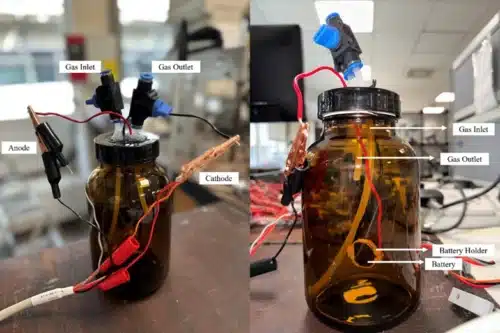The battery stores energy and traps carbon dioxide. It uses materials, works longer, charges, and may help cut pollution on Earth and Mars.

Scientists at the University of Surrey have developed a lithium-CO₂ battery that stores more energy and captures carbon dioxide during operation. This new design offers an alternative to traditional lithium-ion batteries by combining energy storage with carbon capture.
The battery uses a cheaper catalyst, caesium phosphomolybdate (CPM), instead of rare and costly materials like platinum. This switch reduces the production cost and simplifies manufacturing. Earlier lithium-CO₂ batteries struggled with low efficiency, short life cycles, and difficult recharging, but the use of CPM overcomes these issues.
By lowering the overpotential, or the extra energy needed to start chemical reactions, CPM allows the battery to charge and discharge with less energy loss. As a result, the battery operates more efficiently and maintains performance over 100 cycles. This stability is key for long-term, practical use.
Laboratory tests confirmed that lithium carbonate, the compound formed when the battery absorbs carbon dioxide, can be repeatedly created and removed without harming the battery’s performance. This consistent chemical reaction ensures the battery can function reliably over time.
Computer modeling showed that CPM’s stable, porous structure creates an ideal surface for the necessary chemical reactions. This structure supports efficient energy storage while capturing carbon dioxide from the atmosphere.
The battery is made from affordable, scalable materials, removing the need for rare metals. This makes large-scale production more feasible and cost-effective. If commercialized, these batteries could help lower emissions from vehicles and industries by storing clean energy and reducing atmospheric carbon dioxide. There is also potential for their use on Mars, where the atmosphere is mostly carbon dioxide.
With further research, the technology may lead to even better catalysts and stronger battery designs, offering a scalable way to store renewable energy while supporting efforts to cut greenhouse gas emissions.
Reference: “Ultralow Overpotential in Rechargeable Li–CO2 Batteries Enabled by Caesium Phosphomolybdate as an Effective Redox Catalyst” by Mahsa Masoudi, Neubi F. Xavier Jr, James Wright, Thomas M Roseveare, Steven Hinder, Vlad Stolojan, Qiong Cai, Robert C. T. Slade, Daniel Commandeur and Siddharth Gadkari, 30 April 2025, Advanced Science.
DOI: 10.1002/advs.202502553








